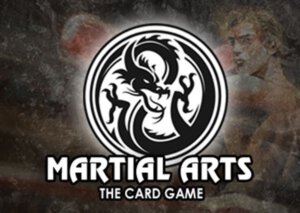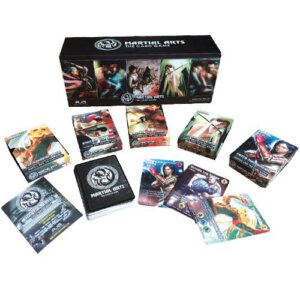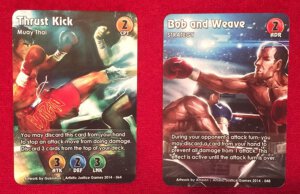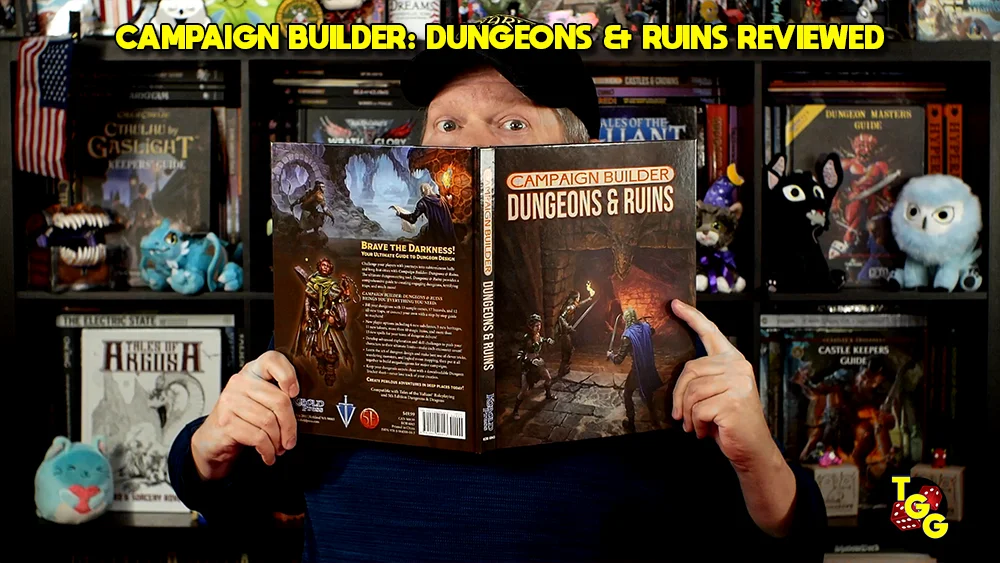
Publisher: Artistic Justice Games
Designer: Alex Lim
Year: 2015 for Kickstarter backers and in stores by early 2016
Genre: Deck building game of martial arts fighting
Players: Two players with option for four players
Ages: 14+
Playing Time: Ten to twenty-five minutes
MSRP: $44.99 for the core set
One of the companies which honestly hadn’t been on my radar prior to Gen Con, though I had an opportunity to learn more about at the show, is Artistic Justice Games. You may have seen my interview with AJG’s Alex Lim and one of the games we spoke about was Martial Arts: The Card Game. The title was successfully Kickstarted and, following a long delay, is supposed to be on its way to supporters and should be in stores in the next couple months or so. The game promises fast paced, back and forth action between two players while utilizing actual martial arts techniques and styles in the card designs and gameplay.
Martial Arts: The Card Game is packaged in a long box reminiscent of what one would normally see other games such as Magic: The Gathering occupy; thus giving the player a convenient storage option while also allowing room for additional decks and cards. In the initial Martial Arts release you’ll find four decks, each dedicated to a particular fighting technique, as well as an additional sparring pack and weapon cards. The four pre-constructed decks are Enter the Phoenix, King of the Ring, Ume and the Blade, and Master of Eight Limbs. The card stock is solid but unspectacular so this is certainly a game that you’ll want to sleeve cards if you’ll be playing a lot. The artwork is pretty good, for the most part, with a touch of an anime/manga feel to the look.
The rule booklet clocks in at ten tiny pages; the booklet layout is the size of one of the cards. Everything is seemingly laid out in a logical manner although I talk about that in just a bit.
Martial Arts is a deck building game so players are encouraged to construct their very own decks using any of the included cards. Each deck must contain at least forty and at most fifty cards to begin. Cards are broken into Attack Cards, Defense Cards, Event Cards, and Strategy Cards.
Cards may contain a CPT factor (Combo Points), ATK factor (Attack Value), DEF factor (Damage Prevention), as well as a LNK factor (The ability to link Combos or Counter Attacks)

Draw Phase – Following the completion of the first turn, the attacking player draws three cards while his opponent draws two. There is no hand size limit and the phasing player can decide to discard their hand and redraw seven cards by forfeiting their attack.
Prep Phase – The active player can play an Event or Strategy Card.
Attack Phase – The active player plays an Attack Card in an attempt to deal damage to their opponent.
Block Phase – The player being attacked may play a Defense or Strategy Card in reaction to the attack. The Defense Card may block any or all of the attacking damage. The defending player may also launch a counter attack. If they do so then they become the attacking player.
Continued Attack Phase – The attacking player may declare another attack if they have the card, or cards, to do so. If not then the phase is skipped.
Resolve Phase – Once again an Event or Strategy Card may be played.
End Turn – The active player ends their turn and allows their opponent to begin their turn. If you’ve run out of card in your draw deck you must reshuffle your discards to create a new deck and give your opponent a free turn. This is called the Recovery Phase.
All of that seems pretty straight forward until you start getting into Combos and Counter Attacks and that is where the wheels fall off the bus a bit as far as the rules go.
In short, a Combo is a chain of attacks which can be strung together as long as A) any damage from the initial attack has been dealt – either blocked or unblocked – and B) the CPT value of the following Attack Card is equal to or greater than the LNK value of the card just played. There’s no limit to how many cards can be strung together in a combo and if your combo attack deals damage you receive a point of ADR. ADR is spent to use some cards you may have in your deck; mainly Event and Strategy Cards.
But…
The defender may launch a Counter Attack if they play a card with a Defense value which blocks any amount of damage. They then have the opportunity to Counter Attack if they play an Attack Card with a CPT value matching the LNK value of the card they just played. The defender then goes on the offensive as the attacking player.
This is where everything gets murky as far as timing and what takes precedence in the Attack Phase. As the rules are written one player could conceivably string together a Combo (Remember all that has to happen is to deal damage from the initial Attack Card) while the other player can Counter Attack (simply playing a card with some sort of Defense and having a LNK/CPT match for the follow up card) and take over the turn to go on the offensive. Nothing is specifically clear as far as the Counter Attack and the wording of the rules regarding them can lead to misinterpretation as well. It certainly led to some debate at our gaming table.
I know most readers will wonder why I didn’t just go online to seek a clarification. My response is that I base my reviews upon what’s in the physical box. I do point out if there are rules revisions available online – and there are for Martial Arts – but what if someone breaks out the game for the first time and don’t have access to the interwebs at that exact moment? Don’t those people have to tackle the game as it’s originally presented?

As for the Event and Strategy Cards? I didn’t find most I looked at to be very interesting or even game changing enough to want to include in your deck. It just seemed like quite a few simply called for both players to discard from their hands or draw decks. A few of the more useful tend to have ADR costs and it isn’t easy to build up ADR points and, if you’ve earned some, the game is probably already over because you strung those Combos together in the first place.
The rule booklet also contains options such as illegal moves and weapons, anything goes mode, and team play.
So what are my overall thoughts on Martial Arts: The Card Game and is it worth your time and money?
This is one of those titles which leaves me really up in the air. There’s just an undercooked feel to the game I can’t shake. The rule booklet is obviously put together by someone who’s familiar with the game but unfortunately probably way too familiar. This is actually a common problem you run into with new game companies coming onto the scene as the game designer is normally the same person who writes the rules. Following months (if not years) of playtesting the designer knows every inch of the game and even how to quickly teach someone the title in a demo. The issue becomes translating that info into the written word for someone picking up their game for the first time; in a demo someone can ask a question and get the answer, yet those common play questions many times don’t get addressed in the final rules presentation. This is why I don’t demo games at conventions, or provide reviews based on convention gameplay, because that’s simply not how the gamer at home is going to learn how to play.
Secondly I find the presentation to be a bit bland. Or maybe I should say lacking pizzazz. I’ll point out I have absolutely no knowledge of the intricate differences in most martial arts techniques. I’m not a complete dunce about it though since I do understand things such as what sets styles like Jujutsu and Muay Thai completely apart. Yet nothing provided in Martial Arts really gives the gamer a feel for the style each deck is built upon. Sure, the King of the Ring is obviously boxing but that about Enter the Phoenix? Beats me. Ume and the Blade? Not a clue. Nor is there any clear indication even while looking through the cards in each deck.
Martial Arts: The Card Game would have been better served by tossing out the idea of the small booklet and replacing it with a large fold out like you see with most CCGs these days. In this way the rules could have been expanded upon with visual examples of play on one side (or even on one side and half of the other) while devoting print space to each of the decks, what techniques they represent, and the sort of player the decks – or even the cards within – will appeal to when constructing your own decks. As it stands now it’s simply along the lines of here are these decks and cards, go knock yourself out.

On the flipside there’s actually a pretty good game under the hood here. Or I can say, the gameplay was fun after we ironed out our interpretation of the Combos and Counter Attacks. Games normally took less than fifteen minutes and everyone who played liked it enough to give it another go or two. If you’re a student of any of the martial arts, or someone educated in many of the styles and techniques, I think the game will draw you in quite a bit. For those whose knowledge extends about as far as old Bruce Lee films or the latest episode of Into the Badlands, I personally think the game’s novelty will wear off after a short while.
I certainly don’t want to dissuade anyone from getting a copy of Martial Arts: The Card Game since it’s going to scratch the itch for the right crowd. Or, in other words, if you’ve been looking for a deckbuilding game where you can pull off Jujutsu moves at the gaming table then this is surely it. Those sorts of folks can give my final score a good point or point and a half bump. For those who wouldn’t know a black belt from a brown belt I would have to say this title probably won’t be your bag of tricks and most likely a pass.
- SOLO BORG is Up for Crowdfunding on Kickstarter - Apr 11, 2025
- Dungeon Crawl Classics: Grave Robbers of Thracia to Land in Stores in May - Apr 11, 2025
- Score Big Savings on the Between Clouds Roleplaying Game - Apr 11, 2025
















